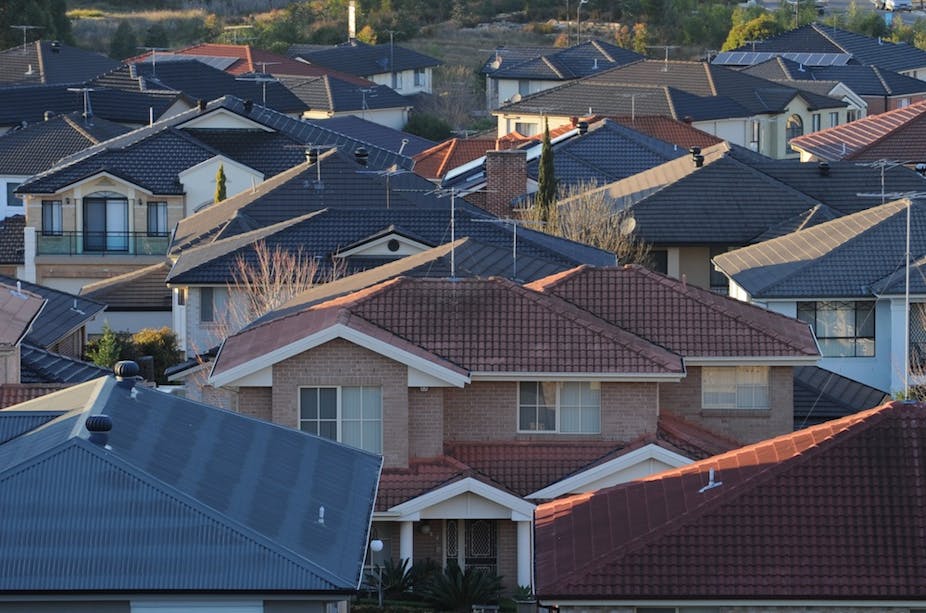The high cost of housing in Australia’s cities is denying most aspiring first home buyers the opportunity to purchase a home. The current high dwelling prices reflect the long boom of the 2000s, when across all Australian metropolitan centres dwelling prices doubled or tripled, with the sharpest escalation being for dwellings close to inner city amenities and high paying jobs.
One consequence is the extraordinarily high level of household debt in Australia. It rose sharply from 100% of annual household income in 2000 to 150% in 2009. It remains at this level – exceeded only by the Netherlands amongst developed countries. Most of this debt is mortgage-related.
Similar dwelling price escalation occurred in Britain and the United States, among other developed nations. What is distinctive about the Australian experience is that there was no contraction in dwelling prices at the time of the global financial crisis.
To the contrary, dwelling prices surged in 2010 when the Reserve Bank sharply reduced interest rates and the Australian government lured first home buyers into the market via additional grants. Since 2010, after a brief and minor price contraction, prices have moved up again, especially in inner-city areas.
An election non-issue
Notwithstanding this situation, the housing affordability issue has barely rated a mention during the election campaign. The reasons are not difficult to discern. There are far more voters happy to see dwelling prices increasing than there are disappointed first home buyers or their sympathisers.
They include those owning or purchasing a home and the army of investors who hold property. Nearly 20% of individuals in Australia aged 45-64 receive income from a rental property. Their ranks are surging with growth in the Self-Managed Superannuation Funds (SMSF) industry. The rules governing these funds were changed in 2007 so that investors can now borrow to finance a property investment with the accompanying tax advantages, including negative gearing.
What if anything can be done about the situation? Even well-informed economists such as Ross Garnaut predicted that Australian dwelling prices would implode, as elsewhere. Among the factors preventing this outcome has been the continued growth in household numbers flowing from historically-high levels of population growth.
This factor has been strong in Sydney and Melbourne because these two cities are the main destinations of overseas migrants. It is not likely that either of the major political parties will address this issue, because both see population growth as a crucial driver of aggregate economic growth, particularly now that the mining investment boom has abated.
Also crucial (until recently) has been the growth in household income in Australia, due to the strong employment situation and the income boost attributable to the decline in import prices resulting from Australia’s favourable terms of trade and the high Australian dollar. This boost is now going into reverse.
While household income was increasing and young people were confident that jobs were plentiful and house prices would keep rising, they were prepared to take the risk of very high mortgage indebtedness.
A new market phase
However, we are in a new phase of the housing market. The middle-income blue and lower white collar demographic that bought house and land packages on the fringes of our major cities during the boom years is less willing or able to do so.
The risk of taking on the typical first home buyer mortgage of $300,000 (more in Sydney) in the current weakening labour market is considered too great by many. The labour market is most precarious for people from this background. This is the major reason why developers are having fewer problems selling apartments off the plan than they are house and land packages on the fringe. The apartment purchases are by local and Asian investors; the fringe purchasers are locals.
First home buyer demand would be greater if house and land packages were cheaper. This has been a central theme of developers. If only the planning rules were less cumbersome and more land was released for subdivision, this would solve the price problem in their view. This proposition has some merit in Sydney, where it has long been state government policy to limit fringe expansion.
This, plus the fragmentation of broadacre land holding, has meant that very few blocks are available for less than $250,000. In Melbourne, by contrast, there is no longer a land shortage. Developer display signs and sales offices are everywhere. They simply cannot sell what they have to offer. Nor can they discount too heavily because the costs of developing land on the fringe have increased, partly because of Government levies designed to deal with infrastructure deficiencies.
Debt legacy
One of the most disturbing issues now emerging is the extent to which those attracted into the housing market during the boom, and especially during 2010, have a heavy legacy of mortgage debt.

These households are vulnerable at a time when jobs are insecure. As is evident from the table, the potential problem is acute for younger households because over a third of these households are paying more than 30% of their household income in mortgage payments. We have included several of the major fringe LGAs in Melbourne because it is where recent new home buyers have been locating.
As awareness of this predicament grows, is it any wonder potential new entrants to the housing market are holding back?

